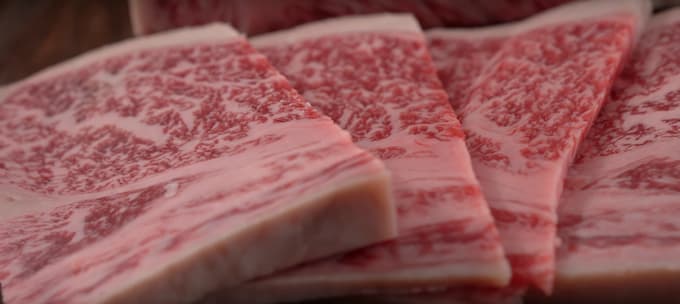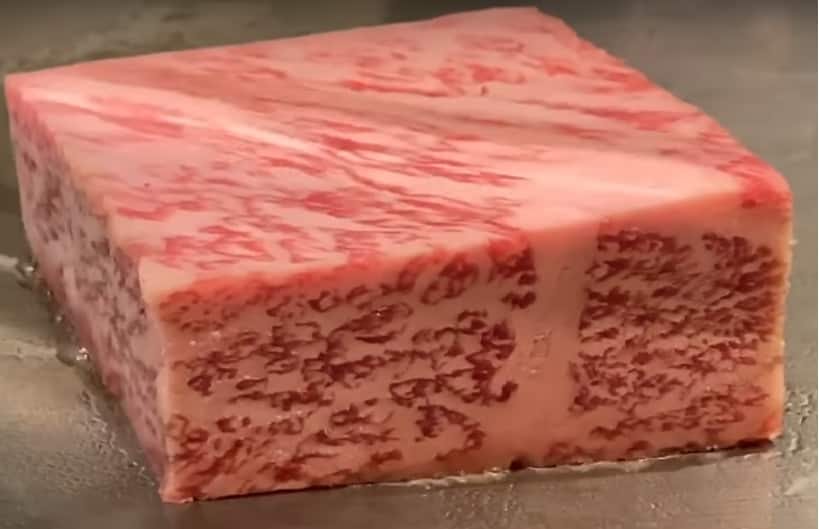There are different types of wagyu beef brands. However, none beats the olive wagyu (Sanuki olive wagyu), a far more rare and expensive wagyu, bred in Shodoshima Island in the Seto Inland Sea, Japan. It has rich marbling and a unique flavor profile. It ranked top in the best fat quality category in the 2017 Wagyu Olympics.
The story of olive wagyu is one of innovation, differentiation, and a push for premium quality. The olive-fed wagyu brand came into being in 2010 after Masaki Ishii’s breakthrough with a olive lees-based feed. He managed to convert the oily and astringent olive lees (olive oil production waste) into a palatable and appetizing cattle feed supplement.
It took Ishii three years to make the olive pulp less off-putting and edible to the cows. He shared his innovation with farmers across Shodoshima and kick-started their journey towards creating a superior and local wagyu brand. The olive wagyu brand soon became prominent in Japan before attracting interest internationally. It has since gained new markets in the U.S., Thailand, and Hong Kong.
Ishii pursued the olive feed combination due to his cows fetching less per kilo compared to the Kobe beef brand despite having the same quality grades. He wanted to create a new brand with a distinct local identity to compete with other established wagyu brands in the Hyogo Prefecture.
What Makes Olive Wagyu Different and Better?

First of all, olive wagyu is high-quality wagyu from cows fed with a repurposed olive lees feed.
Ishii developed a procedure that involves drying and toasting the nutritionally rich but bitter-tasting olive pulp. He then caramelized the naturally occurring sugars to produce a sweet and aromatic black powder added to cattle feed as a supplement.
Olive wagyu is superior to the grass-fed wagyu cows in the Hyogo prefecture. It is distinct or unique in that the farmers in Shodoshima Island use olive lees to breed nutritionally superior cows. For example, olive wagyu has about 1.5 times more glutamic acid than standard Japanese beef. It also has a high peptide content, about 1.4 more than regular Japanese beef.
The high peptide content and glutamic acid contribute to the bold umami flavor that makes olive wagyu much better than Japanese A5 wagyu and Kobe beef. Olive wagyu also has more oleic acid content than regular Japanese beef. Evidence shows that the oleic acid in olive wagyu steak accounts for 65.4% of the total fat content.
It further has two times more carnosine than regular beef. Carnosine is a compound with excellent antioxidant properties. In addition, olive wagyu provides 1.7 more anserine than regular Japanese beef. Anserine is a compound with neuroprotective and antioxidant effects.
Finally, olive wagyu is much more softer. It is 1.2 times more tender than the ordinary wagyu beef.
Why is Olive Wagyu So Rare and Expensive?
Olive wagyu is very rare to find, both locally and internationally. Currently, there are 2200 olive wagyu cows globally.
Olive wagyu farms only slaughter a few animals every month and export a small amount of olive-fed wagyu beef. With this in mind, this type of wagyu is an even rarer treat for people living elsewhere across the world.
Olive wagyu is very expensive. It has a high demand and low supply. A steak from an olive-fed cow goes for $120 but can cost as high as $300 or more.
Is Olive Wagyu Better than Kobe Beef?
Kobe beef is one of the best and most famous wagyu brands. However, olive wagyu beats it hands down in umami flavor, tenderness, and oleic acid content.
The high oleic acid further makes olive wagyu more tender and tastier than Kobe beef. A5 olive wagyu is also many times better than USDA Prime. Essentially, no beef grade in the United States matches the A5 Japanese wagyu.
USDA Prime is at the same level as A2 or A3 Japanese wagyu. Therefore, if you want the best steak overall, you should definitely try A5 olive wagyu.
The Unique Benefits of Olive Wagyu
Olive wagyu has a high monounsaturated fat content
Olive wagyu is not like your regular beef cuts. It has a higher monounsaturated fatty acid content. The resulting intramuscular fat contributes to high marbling and a buttery taste. Oleic acid and other monounsaturated fatty acids promote heart health and help reduce the risk of cardiovascular diseases.
Basically, consuming beef with high oleic acid concentration increases good cholesterol. It also helps reduce the bad cholesterol in the body. As a result, it prevents arteriosclerosis and decreases the risk of developing heart disease.
Olive wagyu has a high glutamic acid concentration
Olive wagyu is one of the healthiest meats, given that it delivers 1.5 times more glutamic acid than regular beef. Glutamic acid is a healthy addition to the diet. It is a building block for protein and acts as a neurotransmitter. It helps the nervous system send and receive messages. This fatty acid also boosts memory and learning.
It further contributes to good gut health and improves outcomes for achlorhydria and hypochlorhydria patients. The high glutamic acid levels can also promote good immune cell function and lead to better immunity.
Olive wagyu has strong antioxidant properties
Carnosine and anserine occur in high concentrations in olive wagyu. They have strong antioxidant properties and help prevent lipid oxidation. From a nutritional perspective, carnosine and anserine help combat cognitive decline, promote muscle health, keep the heart healthy, preserve eyesight, and improve memory.
In addition, they eliminate free radicals in the body, prevent DNA damage, and protect against diseases.
How to Best Prepare Olive Wagyu
Usually, olive wagyu comes in as a frozen product. The best way to defrost wagyu steak is to leave it overnight in the refrigerator. Putting olive wagyu in water or defrosting at room temperature is highly discouraged.
Defrosting in a fridge slows down the process and helps retain maximum quality and texture.
It is also best to sear olive wagyu on a stainless steel pan instead of grilling over an open fire. You should cut the steak into thin strips to ensure it cooks well.
In addition, it is good to keep the seasoning light. For instance, you should sprinkle salt on the steak before searing it on a hot pan. You may also add ground black pepper, depending on your preferences.

